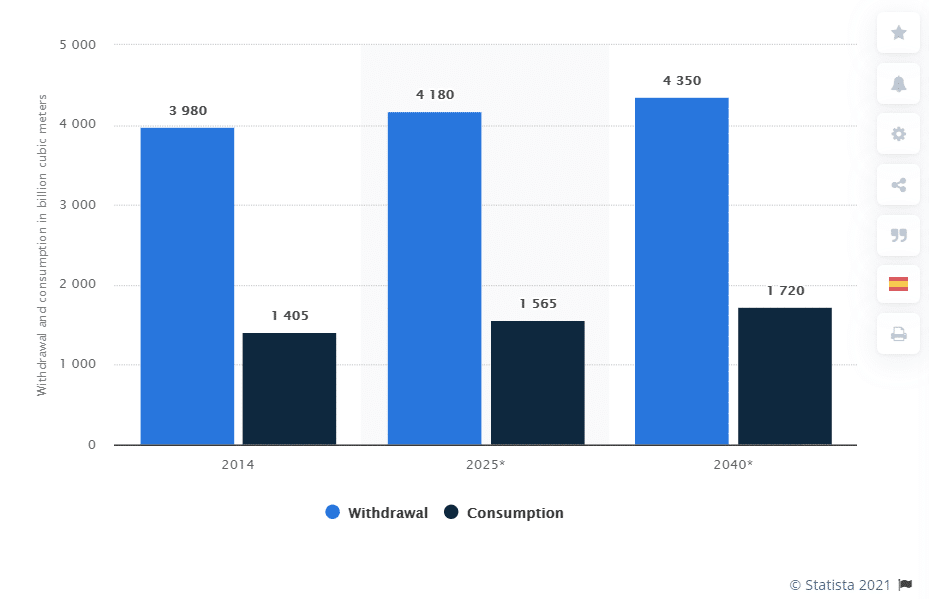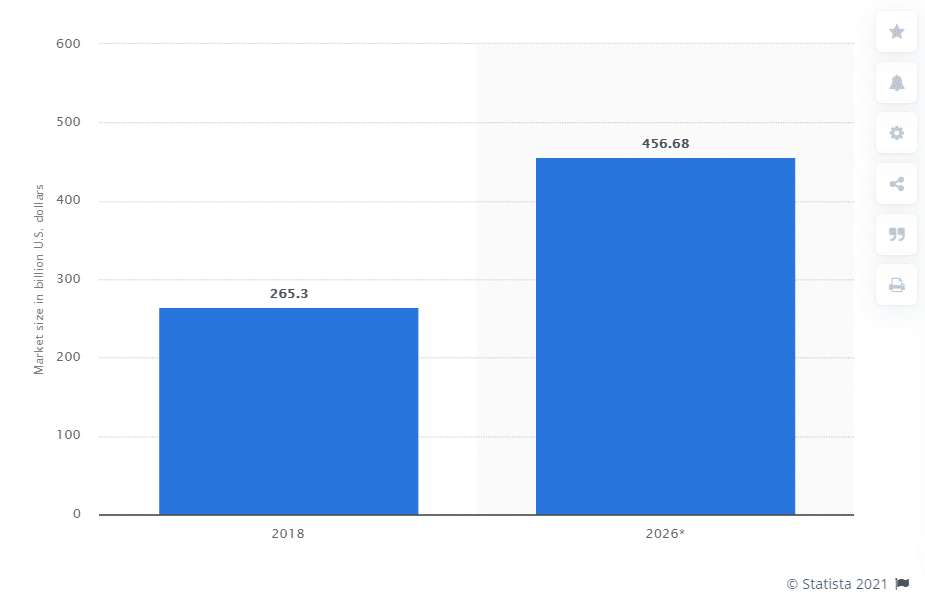Increasing water demand follows population growth, economic development and changing consumption patterns. Global water demand has increased by 600% over the past 100 years and doubled in the last few decades.
Water demand growth is likely to vary based on region and sector. Regionally, water demand growth is expected to come mostly from India, Africa, and other developing countries in Asia. The agricultural industry is one of the largest consumers of water worldwide, primarily for irrigation purposes. Trends in water use will be largely dependent on urbanization, rising living standards, demand for goods, and changes in dietary preferences.
It is projected that global water demand will reach 4,350 billion cubic meters in terms of withdrawal by 2040.

Market size of the water and wastewater treatment
Growing populations and freshwater shortages are set to increase the demand for water and wastewater treatment worldwide. Water demand cannot exceed water availability. The available surface water resources are forecast to remain about constant at continental level, although quality will deteriorate, and spatial and temporal distribution will change. More likely, aquifers will shrink, and salt intrusion in coastal areas will be very dramatic.
In contrast, the growth of population, gross domestic product (GDP), and water demand will increase globally and unequally. Changes will be much more pronounced at the sub-regional level than at the country level, and the global average.
As freshwater availability is declining, the demand for water treatment systems will going to increase. The wastewater recycling and reuse can be alternative way to fulfil the demand in water scarce regions. This will further give rise to demand of wastewater recycling systems in the coming years. In 2018, the global water and wastewater market was valued at 265 billion U.S. dollars. The market is forecast to be valued at 456 billion U.S. dollars by 2026.

Sector Wise Market
Water industry can be divided into four subsectors:
- Water Distribution: A water distribution system is a part of water supply network with components that carry potable water from a centralized treatment plant or wells to water consumers in order to adequately deliver water to satisfy residential, commercial, industrial and firefighting requirements.
In India, this sector is mostly administrated by the municipalities for public water supply and pollution control board for Industrial water supply. Typical components of the distribution system are storage tanks, pipes, valves, connections, manifolds, shut-off valves and hydrants.
- Purification: Most of the time surface water is not fit for direct consumption. Therefore, treatment and removal undesirable chemicals, biological contaminants, suspended solids, and gases from water is essential before use it for specific purposes.
For public water supply, municipalities are responsible for water purification in India. The components of water purification systems include composite tanks and vessels, control valves, filtering media and consumables, brine tanks, fittings and distributors etc.
But it has been observed very often, when there is insufficient availability of water or distribution line is not available in the locality, groundwater is extracted and supplied directly to the households without any purification. In such case, people need a domestic purification system which shall include RO purifiers, water softeners etc.
- Wastewater Treatment: Globally, 80% of wastewater flows back into the ecosystem without being treated or reused. Water scarcity around the world is putting pressure on the authorities to protect the freshwater resources from wastewater contamination and also explore the opportunities to recycle and reuse the wastewater to cut down overall water demand.
Major components of wastewater treatment plant include: bar screens, grit chamber, comminutors, pre-aeration tank, aerators/mixers, settling tanks, biological filters, coagulants/flocculants, clarifiers, sludge handler etc. - Desalination: More generally, in this process the sea water is converted into potable water by removing salts and minerals from the water. Desalination is adopted in the coastal region where there is less availability of freshwater and groundwater is deep or deteriorated. Some industries like thermal power plant also adopt this process. This is the most expensive water treatment method. The seawater desalination by RO system consists of pretreatment system, high pressure pump and RO membrane.
The water market is growing in importance under the complications of limited water resources and growing populations. As of March 2021, wastewater treatment (Industrial and domestic) accounted for about 66 percent of the global water industry market share. followed by the water purification, water distribution and desalination.

Market by Geographies
As of 2018, the water & wastewater treatment market in North America was worth USD 104.53 billion and this value is projected to increase further in the coming years. Besides North America, the market Asia Pacific will witness considerable growth in the coming years driven by massive investments by countries such as China, India, and Japan.
Indian Water Market Overview
In India, Water and Wastewater Treatment (WWT) Technology Market was valued at USD 2,042.91 million in 2020 and the market is projected to register a CAGR of 8.55% during the forecast period (2021-2026).
According to Financial Express, by 2030, India’s water demand will exceed supply by two times, indicating severe water scarcity in the country. The average all-India per capita water availability is expected to be 1,341 cubic meters by 2025, and touch a low of 1,140 cubic meters by 2050, close to the official water scarcity threshold.
This shortage of water for industrial and residential use is expected to increase the demand for such water treatment systems in the long run. Therefore, the treatment equipment is expected to dominate the market in the coming years.

Challenges in Indian Market
- The Indian water industry is very cost competitive, this limits the entry of expensive technologies. However, niche technologies are not limited by these conditions.
- Product demonstration is often needed to show how technology performs (Pilots).
- The ease of doing business with government bodies still remains a great challenge.
Way forward
Water is a critical resource which is important for Country’s economic growth, public health and ensuring environmental sustainability. The innovative and cost-effective solutions can fit in very well in the fast-moving Indian market.

